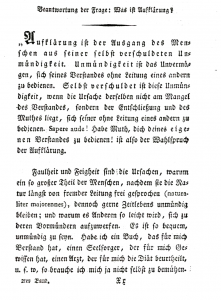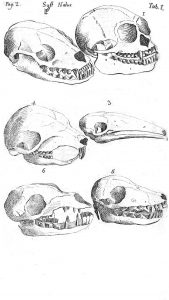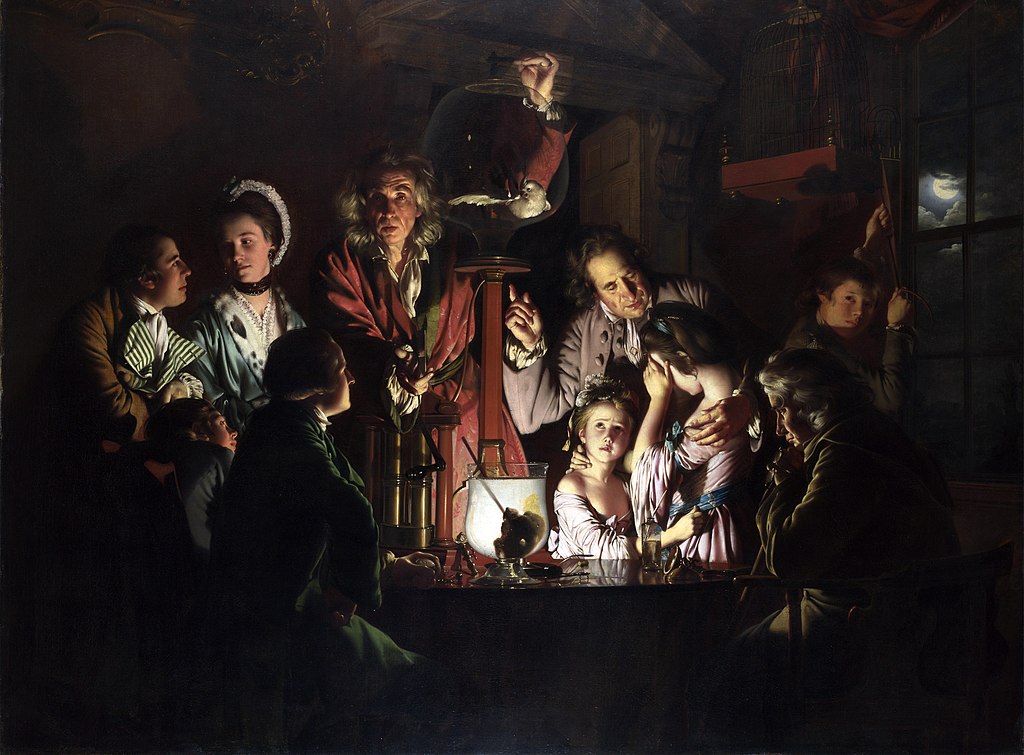—Accounts, myths and superstitions about the Enlightenment and its relationship with the sciences.—
In 1783, a parish priest in Berlin, Johann Friedrich Zöllner, asked a question in a magazine: ‘Was ist Aufklärung?’ (What is Enlightenment?) The most famous answer was sent by Immanuel Kant, in which has become one of the most famous texts in the history of philosophy. He defined Enlightenment as ‘man’s emergence from his self-imposed immaturity’, that is, from ‘the inability to use one’s understanding’ without any other guidance. Kant considered that the cause of this inability was not lack of intelligence, but rather lack of ‘resolve and courage’ to use reason without any tutelage. That is why he exhorted his contemporaries: “Sapere aude! (Dare to know!) Have the courage to use your own reason!” This seemed to Kant to be the motto of Enlightenment.

Immanuel Kant’s answer to the question “What is the Enlightenment?” appeared in December 1784 in the journal Berlinische Monatsschrift. Wikimedia.
This vision of the Enlightenment, considered to be the triumph of reason, has shaped many of the accounts of the history of science of this period. These accounts present this period as the consolidation of advances made in previous centuries, that is, in the epoch of the ‘Scientific Revolution’ and the period of the ‘birth’ of modern science. For example, with regard to the physical sciences, the ‘triumph of reason’ is usually identified with the ‘spread’ of Newton’s work, both his understanding of mechanics and astronomy, and his working methods, which are presented as paradigmatic examples of the experimental method. Within this more traditional vision, the science of the Enlightenment, at least in the field of physics, had little originality and was limited to a process of ‘consolidation’ and ‘assimilation’ of the knowledge of the previous two centuries. It would thus be a less than fascinating period, characterised by the slow spread of the great achievements of the previous one.
This vision of the Enlightenment is not sustainable in the light of the historical research of recent decades. This research, as it has been possible to see in other sections of Knowledge in Action, has questioned the notion of the ‘Scientific Revolution’ on which the previous lines are based. Also, in recent years there has been a greater interest in the processes of the circulation of science. From this perspective, historians have analysed in detail the complex processes, with the participation of a large number of historical actors, that led to the transformation of Newtonianism into the ‘common sense’ of the physical sciences, according to the expression used by Simon Schaffer. It has also been found that, even in the limited area of what is now known as the physical sciences, there were many more relevant issues than the creative circulation of Newton’s works. The years of the Enlightenment, even in areas such as astronomy or mechanics, were full of innovations, related to astronomical observations, instruments, experimental practices and theoretical approaches of a very diverse type.
Beyond astronomy and mechanics, the account of the ‘triumph of reason’ has also been applied to other fields, such as chemistry and medicine. In the case of the history of chemistry, the period of the Enlightenment is usually presented as the liberation from its ancient relationship with alchemy, this discipline being considered as part of “the aberrations of the human intellect”, as one of the first historians of chemistry, Thomas Thomson, wrote. For these early chemist-historians, the Enlightenment was a process in which chemistry had detached itself from these ‘rude and disgraceful beginnings’ in order to gain its ‘dignity’ as a science. It has been seen in other sections that these images of alchemy, created by authors such as Thomson with the aim of strengthening the public image of chemistry, have no place in current historical research.
Another image that has also been abandoned, but that continues to have a lot of weight in scientific dissemination and in some school narratives, is the idea of a ‘delayed revolution’ in the field of chemistry. According to these accounts, this revolution occurred through the abandonment of the so-called phlogiston theory, all this through the advance of precision and quantification (virtues symbolised by the weighing scales as a chemical instrument) and increasingly complex experiments and with ever more sensitive devices. Thus, and always through the intervention of great geniuses like Antoine Lavoisier (1743-1794), Chemistry had its revolution a century later than the other physical sciences. This image was formulated by historians such as Henry Butterfield in works with the significant title The Postponed Scientific Revolution in Chemistry.

Images of animal skulls reproduced in the book by Carl Linné, Systema Naturae, 1748. Wikimedia.
Within this type of narrative, still present in current science manuals, the role of founding geniuses was crucial. In botany, a role similar to that of Lavoisier in chemistry is usually attributed to the figure of Carl Linné (1707-1778). His role was to introduce new classifications and the systematisation of a new binomial nomenclature that also inspired the reform of chemical and medical terminology during the eighteenth century. In reality, his work was based on a very wide exchange network of data and objects of all kinds, so this should be considered a collective enterprise that, moreover, was marked by the relationships of exchange between the imperial powers of the time. His classifications are also marked by gender biases and values as to the role of women, containing an implicit naturalisation of the sexual division of labor in the societies of his time, as shown by the works of Londa Schiebinger. As in the case of Linné, new studies on science in the Enlightenment recover aspects such as the collective nature of scientific production, imperial networks for the exchange of objects or gender biases, which are hardly dealt with at all in traditional accounts.
In the case of medicine, it is often claimed that the so-called ‘clinical revolution’ of the early nineteenth century was preceded by the drawn-out crisis of Galenic theories. The critical thinking of the Enlightenment served, always from this point of view, to question the medical systems (not only Galenism, but also iatrochemistry or iathromechanics). Thus, it led to a sceptical or anti-systemic period that served as a starting point for the birth of modern medicine, usually represented by the Paris school with the so-called ‘clinical revolution’ and the emergence of ‘hospital medicine’, notions which are present in works written during the 1960s by authors as different as Michel Foucault or Erwin Ackerknecht. Again, new studies have shown a rather different and more complex picture. It has been seen that many supposedly revolutionary changes were gradually introduced into the schools of surgery of the eighteenth century. It has also been shown that many images of the ‘clinical revolution’ were created and popularised through accounts from the medical community in the second half of the nineteenth century.

An experiment with a bird inside a vacuum machine. Painting by Joseph Wright of Derby, 1768. Wikimedia.
As with the “clinical revolution”, the above-described interpretation of the Enlightenment and the sciences, though abandoned in the academic world, continues to have a strong public presence, both in science teaching and in works for the general public. This includes best-selling books, such as Enlightenment now! by Steven Pinker, who employs the traditional vision of the Enlightenment to defend “reason, science, humanism and progress” against its supposed detractors, that is, all those who, in one way or another, question the virtues of contemporary capitalist societies that, according to Pinker, would be the strongest proof that “the Enlightenment has worked”. Critics of the vision defended by Pinker, however, start from Enlightenment itself, where various more or less radical tendencies coexisted, with opposing views as to the role of science and reason. In the academic field, criticism of the traditional image of the Enlightenment has been carried out from many different angles. One of the sources of inspiration were the authors of the so-called Frankfurt School, with the notion of ‘instrumental reason’, which was subject to economic utility or interest, and not so much to the knowledge and prudence used in the texts of Max Horkheimer and Theodor Adorno, written after the terror of the Second World War. Another notion that emerged in this same school, formulated by Jürgen Habermas, has also had great importance in historical studies: the birth of the “public sphere” (Öffentlichkeit) and the role of science in this context. Finally, the works of Michel Foucault, who also wrote an answer to the question that gives this entry its title, have highlighted the relationships between knowledge, discipline and power. In contrast to the traditional association between the development of reason and the increase of freedoms, the Enlightenment according to Foucault, however, has initiated a shift towards new forms of submission and “biopower”.

An experiment with static electricity in an 18th century salon. From the book Essai sur l’électricité des corps, by Abbé Nollet (Paris, 1771). Bibliothèque Nationale de France.
Inspired by these works, new studies have paid more attention to the arrival of science in the public sphere, in the new social spaces that emerged in those years (cafés, salons, academies), new media (particularly newspapers, the great novelty), forms of reading (collective and private) and a new type of discourse and irreverent attitude towards political, religious or academic dogmatism. Discourses on the “common good” and “public usefulness” of new knowledge, a characteristic feature of the Enlightenment, would also be reviewed. It is also common to find discourses that associate the dissemination of knowledge with economic growth and public prosperity, in processes that can be exemplified by the famous Diderot and D’Alembert’s Encyclopédie, the great publishing venture of the eighteenth century, containing many topics that today would be related to physics, chemistry, medicine or mathematics. Central European politicians in the legislative chambers, as well as other members of enlightened governments and some of the elite of those years, saw science as a tool to renew agriculture and industrial production, promoting courses aimed at farmers and artisans.
Along with this rhetoric of usefulness, and often confused with it, knowledge related to science would serve as a source of entertainment and spectacle. A trade would be created for instruments to be used in homes or by demonstrators who would tour Europe, with their extensive series of experiments delighting very diverse audiences, thus combining entertainment with usefulness. Among these audiences, women, who were important protagonists, played a prominent role, as will be seen. Therefore, the Enlightenment period is particularly interesting to review science and gender issues, given that many women also actively participated in the production of knowledge, often from spaces such as the society salons where the social norms favoured their participation. There were also authors, sometimes anonymous, of important scientific works, some of whom became fully integrated into the academic world, as shown by Laura Bassi’s career as a professor of physics at the University of Bologna.
In this way, new work has allowed plural views on the Enlightenment that go far beyond traditional themes and self-interested interpretations such as those mentioned above. These new themes appear fully established in volumes of compilations with overviews of science, medicine and technology during the Enlightenment, such as those described in the attached bibliography. These works deal with a whole series of new topics, hardly dealt with in traditional descriptions, such as scientific instruments and their manufacturers, industrial production, trade and the reading of books, science and religion, technological change, science and gender, visual cultures, great expeditions, trade and imperial plunder, etc. Numerous studies have also been carried out into territories and cultures located outside Europe, to find out the perspective of usually silenced voices. A look at more recent manuals, such as the one edited by Dominique Pestre, shows the consolidation of these issues and the extension to new ones, for example, related to the global circulation of knowledge through the imbalances between mother countries and colonies, public spectacles such as hot air balloons, environmental history and new forms of pollution caused by the Industrial Revolution, the growing collaboration between academic, political, and economic power, etc. Many of them will be addressed in the following episodes of Knowledge in action.
José Ramón Bertomeu Sánchez
IILP-UV
How to cite this paper:
Bertomeu Sánchez, José Ramón. What is Enlightenment? Sabers en acció, 2020-12-21. https://sabersenaccio.iec.cat/en/what-is-enlightenment/.
Find out more
You can find further information with the bibliography and available resources.
Recommended reading
Bertomeu Sánchez, José R.; Antonio García Belmar. La Revolución Química: Entre la historia y la memoria. Valencia: PUV; 2006.
Clark, William et al. eds. The Sciences in Enlightened Europe. Chicago: University Press; 1999.
Fara, Patricia. An Entertainment for Angels. Electricity in the Enlightenment. Cambridge: Icon Books; 2002.
Fara, Patricia. Pandora’s Breeches :women, Science and Power in the Enlightenment. London: Pimlico; 2004.
Hankins, Thomas L. Ciencia e Ilustración. Madrid: Siglo XXI; 1988.
Pestre, Dominique et al. (eds.) Histoire des sciences et des savoirs. Paris: Éditions du Seuil, 2015. Vol. I.
Porter, Roy (ed.) The Cambridge History of Science. Eighteenth-Century Science. Cambridge: Univ. Press; 2003.
Studies
Ackerknecht, Erwin. Medicine at the Paris Hospital: 1794-1848. Baltimore: The Johns Hopkins Press; 1967.
Bertomeu Sánchez, José R.; A. García Belmar. La Revolución Química: Entre la historia y la memoria. Valencia: PUV; 2006.
Broman, Thomas. “The Habermasian Public Sphere and ‘Science “in” the Enlightenment.’” History of Science. 1998; 36: 123–49.
Clark, W., et al. The Sciences in Enlightened Europe. Chicago: University Press; 1999.
Foucault, Michel. La Naissance de la Clinique: Une Archéologie du regard médical. Paris: PUF; 1963.
Foucault, Michel. Surveiller et punir : Naissance de la prison. (Paris: PUF, 1975).
Frize, Monique. Laura Bassi and Science in 18th Century Europe: The Extraordinary Life and Role of Italy’s Pioneering Female Professor. Berlin ; New York: Springer; 2013.
Gavroglu, Kostas, et al. “Science and Technology in the European Periphery: Some Historiographical Reflections.” History of Science. 2008; 46 (2): 153–75.
González Bueno, Antonio. Linneo: El príncipe de los botánicos. Madrid: Nivola libros y ediciones; 2001
Habermas, Jürgen. Historia y crítica de la opinión pública. Barcelona: Gustavo Gili; 1994
Hankins, Thomas L. Ciencia e Ilustración. Madrid: Siglo XXI; 1988.
Hannaway, Caroline.; La Berge, Anne (eds.) Constructing Paris Medicine. Amsterdam: Ed. Rodopi; 1998.
Horkheimer, Max, Theodor W. Adorno. Dialéctica de La Ilustración. Madrid: Trotta; 2003.
Pestre, Dominique et al., eds. Histoire des sciences et des savoirs. Paris: Éditions du Seuil; 2015.
Porter, Roy (ed.) The Cambridge History of Science. Eighteenth-Century Science. Cambridge: University Press; 2003.
Porter, Roy, and George Sebastian Rousseau, eds. The Ferment of Knowledge: Studies in the Historiography of Eighteenth-Century Science. Cambridge [etc.]: Cambridge University Press; 1980.
Raj, KapiL. Relocating Modern Science. Circulation and the Constitution of Knowledge in South Asia and Europe, 1650-1900. New York: Palgrave; 2007.
Schaffer, Simon. et al. The Brokered World. Go-Betweens and Global Intelligence, 1770-1820. Science History Publications; 2010.
Schaffer, Simon. Trabajos de Cristal: Ensayos de Historia de La Ciencia, 1650-1900. Madrid: Fundación Jorge Juan: Marcial Pons Historia; 2011.
Schiebinger, Londa. Tiene Sexo La Mente?: Las Mujeres En Los Orígenes de La Ciencia Moderna. Valencia: PUV; 2004.
Sutton, George. Science for a Polite Society. Gender, Culture and the Demonstration of Enlightenment. Boulder: Westview Press; 1995.
Thébaud-Sorger, Marie. L’Aérostation Au Temps Des Lumières. Rennes: PUR; 2009.
Sources
Kant, Immanuel. Contestación a la pregunta: ¿Qué es la Ilustración? Madrid: Gredos; 2010.



